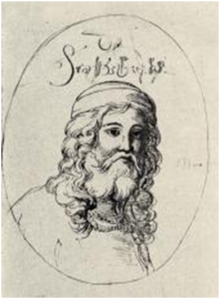Abaza riots
The Abaza uprisings were rebellions against the Ottoman Empire during the reigns of Mustafa I and Murat IV. Abaza Mehmed , an Ottoman pasha of Abkhaz origin, was the leader and namesake . In some sources the uprisings are seen as part of the Celali uprisings . But unlike the other Celali revolts, the main reason for the Abaza rebellion was resentment against the Janissaries .
backgrounds
The Ottoman Sultan Osman II had besieged the city of Chotyn as part of the Ottoman-Polish War , but could not take it. For the failure of the siege, he blamed the stubborn Janissaries. The Janissaries, once elite troops of the Ottoman Empire, had been corrupted during the empire's stagnation. Osman then planned to create a new army with Oghuz from Anatolia. The announcement of military reforms caused an uprising among the Janissaries in the capital, Istanbul. Osman II was arrested by the Janissaries on May 20, 1622 and later strangled.
First uprising (1622-1624)
Abaza Mehmed († 1634) was born in the 16th century. From 1617 he was Beylerbey of Maraş , from 1621 then of Erzurum . According to the historian Joseph von Hammer-Purgstall , he was an advisor to Osman II in his efforts to abolish the Janissaries. Shortly after hearing the news of the assassination attempt on the Sultan, he began to evict and kill the Janissaries on duty in his province. Abaza Pasha then besieged the fortress of Karahisar , where an army of 10,000 men was stationed. After a few days, the Ottoman army had to surrender and joined Abaza Mehmed.
Although he was officially released from the Sublime Porte on November 17, 1622 , he continued to stay in Erzurum, claiming he was loyal to the Porte, but tried to punish those responsible for the assassination attempt. In particular, the Yörüken in Central Anatolia also accused the Janissaries and joined the Abaza uprising, so that the latter soon controlled most of eastern and central Anatolia.
In 1624 the gate finally decided to fight Abaza. Grand Vizier Çerkes Mehmed Ali Pascha went on a campaign to Eastern Anatolia, the army commander ( Serdar ) was Hafiz Ahmed Pascha. The clash took place on August 16, 1624 in the plain near Kayseri on the Karasu River. During the battle, some soldiers of Abaza's army switched sides, others refused to fight, and Abaza's forces were defeated. Abaza fled to Erzurum and was able to convince the porte of his good intentions during the following conversations. Therefore, he was allowed to remain governor. The only condition of the Grand Vizier was the admission of ten Janissaries into the fortress.
Second uprising (1627/28)
During the Ottoman-Safavid War (1623-1639) the Persian army threatened the Ottoman city of Ahıska (today Akhaltsikhe in Georgia ) in August 1627 . Abaza was ordered to support the Ottoman army. The pasha asked for command of the army as a serasker , but the grand vizier refused. Abaza Mehmed then assembled his troops near the battlefield, but waited for a suitable moment and was finally able to ambush the Ottoman army. In addition to the Janissaries, many Ottoman pashas were also killed. Abaza Mehmed then moved to Erzurum and killed the Janissaries there too. The Persians were able to take Ahıska without much resistance.
After this humiliating defeat, the Grand Vizier Damat Halil Pasha besieged the fortress of Erzurum, but had to close it after 70 days due to the onset of winter. Although some of Abaza's followers have since defected, the Sultan dismissed the Grand Vizier at the beginning of April 1628. Gazi Hüsrev Pasha became the new Grand Vizier . In September 1628 the new Grand Vizier besieged Erzurum surprisingly quickly again. Abaza was taken by surprise by this new siege and could no longer stockpile. So he had to give up on September 18, 1628. Hüsrev Pascha accepted his conditions. Abaza was not punished and was transferred as governor to provinces in the European part of the empire (Bosnia and Özi, now Ochakiv ), where he had no local support.
Individual evidence
- ^ Mehmet Süreyya: Sicill-i Osmanî . Türkiye Kültür Bakanlığı and Türkiye Ekonomik ve Toplumsal Tarih Vakfı, Istanbul 1996, p. 1039.
- ^ Joseph von Hammer-Purgstall : From Murad the Fourth's entry into government to the appointment of Mohammed Köprili as Grand Vizier. 1623-1656 . (= History of the Ottoman Empire: mostly from previously unused manuscripts and archives ), CA Hartleben's Verlag, Pest 1829, p. 26
- ^ Joseph von Hammer-Purgstall (1829), p. 27
- ↑ Lord Kinross: The Ottoman Centuries . Altın kitaplar, Istanbul 2008, ISBN 978-975-21-0955-1 , p. 295
- ↑ Joseph von Hammer-Purgstall (1829), pp. 33–35
- ↑ Joseph von Hammer-Purgstall (1829), pp. 72–76
- ^ Joseph von Hammer-Purgstall (1829), p. 77
- ^ Joseph von Hammer-Purgstall (1829), p. 81
- ^ Joseph von Hammer-Purgstall (1829), p. 83
- ^ Yaşar Yücel, Ali Sevim: Türkiye Tarihi . Volume III, AKDTYKTTK Yayınları, Istanbul 1991, p. 69
